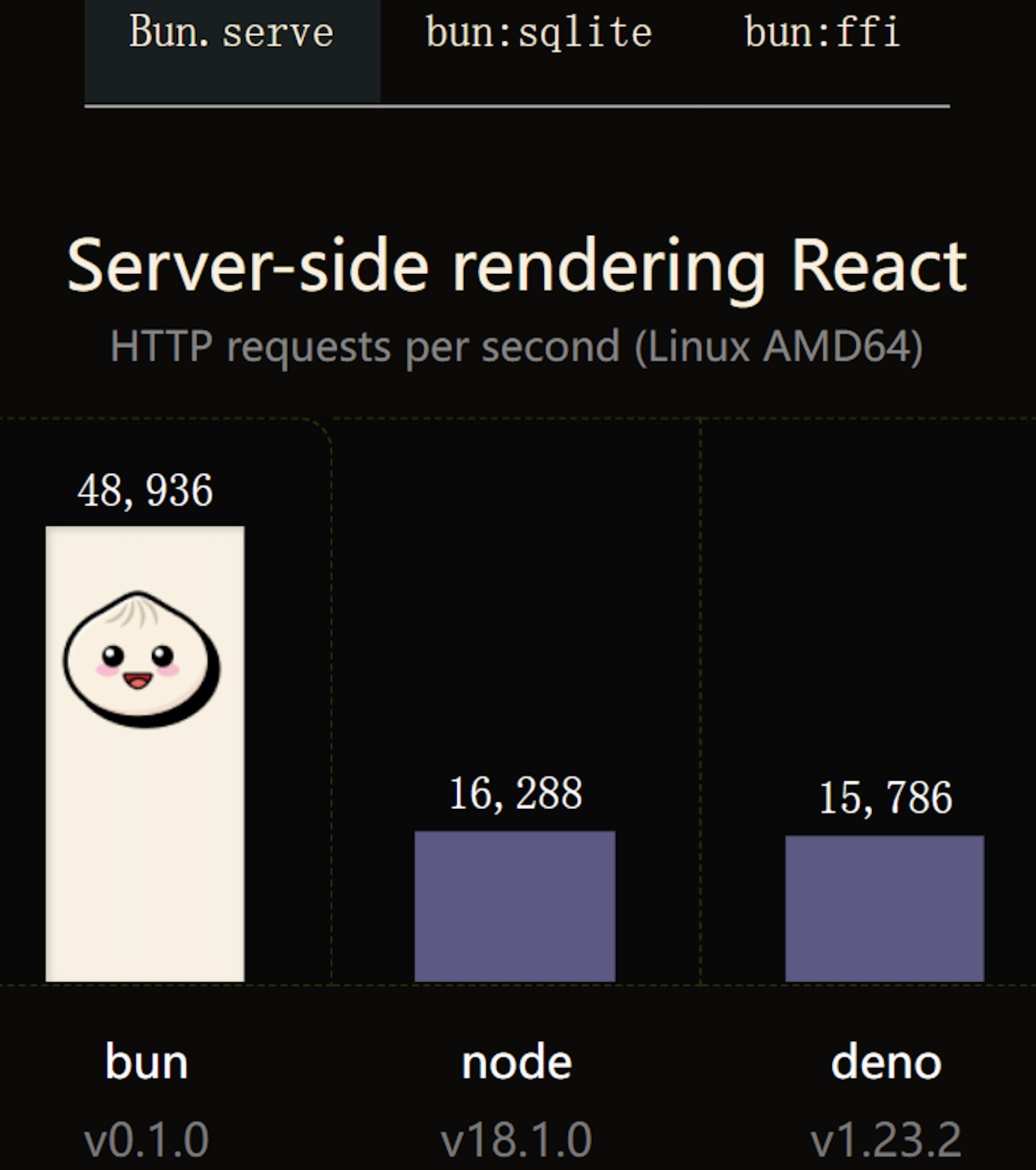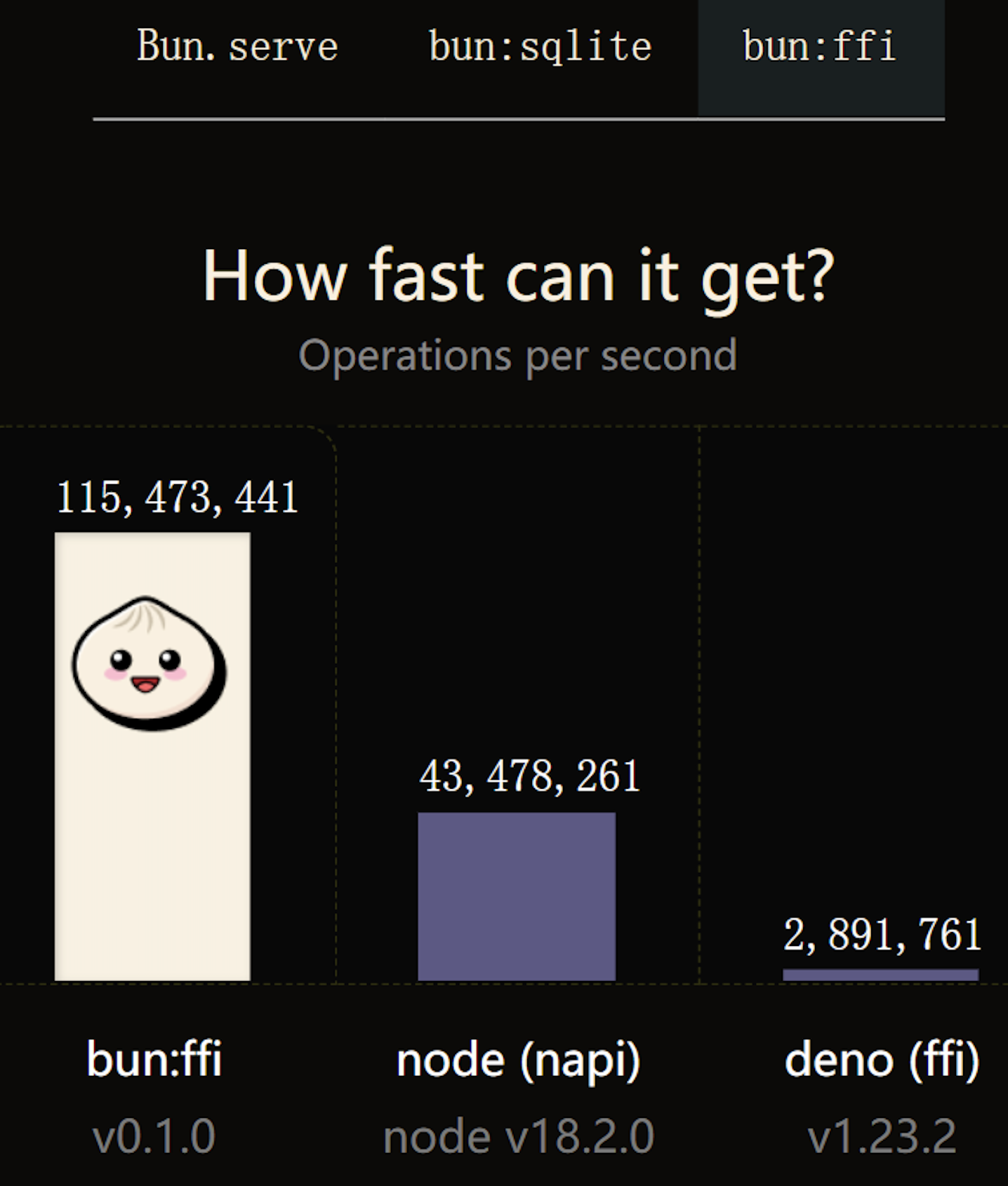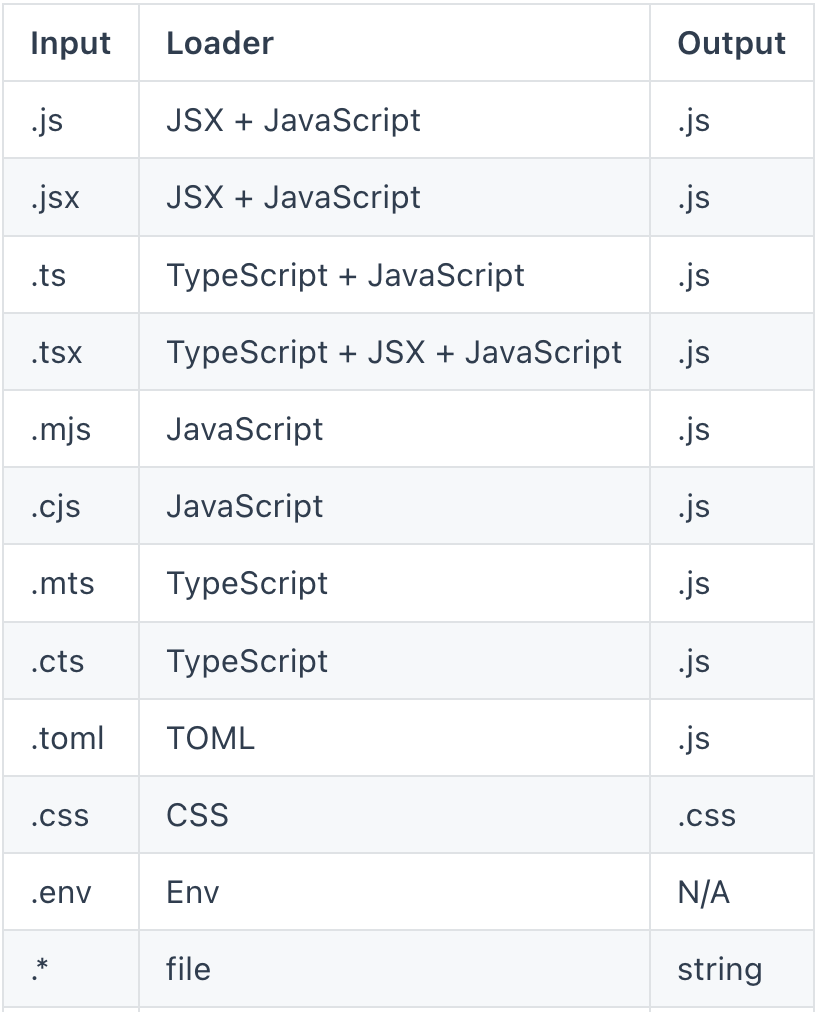了解 Bun 以及安装
什么是 Bun
Bun (读音类似于[bʌn],包子的意思) 是一个像 Node 或 Deno 这样的现代 JavaScript 运行时;
通俗一点讲就是你可以在 Bun 上运行 JavaScript 代码,你是不是在想这不是跟 Node 和 Deno 一样的吗,这也能火?
别急嘛,咱们往后看;
all-in-one
官方还称其为:all-in-one JavaScript runtime
所谓 all in one,是因为 Bun 和 Node.js 这种传统的 javaScript 运行时 不同;Bun 提供了打包、转译、安装和运行 JavaScript & TypeScript 项目的功能,内置原生打包器 (native bundler)、转译器、task runner、npm 客户端,以及数百个 Node.js API 和 Web API,包括约 90% 的 Node-API 函数(本机模块)、fs、path、Buffer 等。
这就意味着你可以实现在 Bun 上运行的大部分 Node API 和 Web API, 还可以在不需要使用 Webpack、Rollup、esbuild、babel等工具的前提下直接运行TypeScript 、JSX 了
乍一看,是不是瞬间档次高了许多?
但是这样还不足以让你在同事、面试官的跟前吹 🐂 🍺
各位看官,您继续往下看…
为什么用 Bun
性能测试结果
- 服务器端渲染 React:每秒的 HTTP 请求数

- 加载一个大型数据表:每秒平均查询次数

- FFI:每秒操作数

根据上面 服务器端渲染、加载大型数据表、FFI 三个方面来对比,可见 Bun 可以说在性能方面是吊打 Node.js 和 Deno
为什么快
- 引擎差异
不同于 Node.js 和 Deno,Bun 并没有基于 V8 引擎,而是使用了 JavaScriptCore 引擎,它的执行速度往往要比 V8 等更传统引擎要快。 - 语言差异
Bun.js使用的是新兴的系统编程语言 ZIG 编写的,主要通过手动内存管理对内存进行更细粒度的控制、无隐藏的控制流来提升程序的性能; - 从零开始
在上两点的前提下,Bun.js 的大部分内容都是完全从零开始编写的,包括 JSX/TypeScript 转译器、npm 客户端、打包器、SQLite 客户端、HTTP 客户端、WebSocket 客户端等等。
注意:ZIG 是一门系统级编程语言,专为稳定性、可维护性和性能而设计,是追求替代 C 语言在系统编程上的最佳地位。
内置兼容性
- Web API 支持,对 fetch、WebSocket、 ReadableStream 等 API 都提供了内置支持;
- Node.js模块,Bun 实现了 Node.js 的模块解析算法,,以便我们可以在 Bun 中使用 npm 包,同时支持 ESM 和 CommonJS,但 Bun 内部使用 ESM;
- Bun.js 实现了大部分 Node-API (N-API),大部分 Node.js 原生模块及全局变量(比如Buffer 和 process)都可以正常工作;
- 自动加载环境变量 .env 文件,不需要再 require("dotenv").load();
- 附带一个内置的快速 SQLite3 户端 bun:sqlite;
- 内置 JavaScript、TypeScript、JSX 等(见下表)各种转译器;

通过上述大家能发现,Bun 的目标是想在浏览器之外运行 JavaScript,为我们的基础架构带来性能和复杂性的增强,并通过更好、更简单的工具提高开发人员的生产力。
快速上手
Mac/Linux 上安装
安装
curl https://bun.sh/install | bash新建 http.js
export default { port: 3000, fetch(request) { return new Response('Welcome to Bun!'); }, };运行
bun run http.js浏览器中打开:
http://localhost:3000即可注意:如果使用 Linux,强烈推荐内核版本 5.6 或更高版本,但最低为 5.1
Bun 的常见功能使用
1. 当做包管理器使用
通过 package.json 安装依赖
bun install新增或删除 package.json 中的某个安装包
# 删除 bun remove react # 安装 bun add preact
根据测试,在 Linux 上 bun install 运行安装包速度往往比 npm install 运行脚本快 20 - 100 倍。
2. 直接运行scripts脚本
用 bun run 来代替 npm run
# 代替 npm run clean bun run clean # 这个也可以 bun clean运行 package.json 中的脚本
# 创建 package.json { "name": "myapp", "scripts": { "clean": "rm -rf dist out node_modules" } } # 在终端中运行以下命令 bun run clean
根据测试,bun 运行 package.json 脚本比 npm 运行 package.json 脚本快 30 倍
3. 快速创建 Next.js 项目
快速创建
# 创建 bun create next ./app # 运行 cd app bun dev # start dev server关联一个已经存在的 Next.js 应用
bun add bun-framework-next echo "framework = 'next'" > bunfig.toml bun bun # bundle dependencies bun dev # start dev server
注意:Next.js 的需多功能都支持,但是也有小部分暂时不支持,所以生成环境使用需谨慎
4. 快速创建 React 项目
快速创建
bun create react ./app cd app bun dev # start dev server关联现有的React项目
# To enable React Fast Refresh, ensure it is installed bun add -d react-refresh # Generate a bundle for your entry point(s) bun bun ./src/index.js # jsx, tsx, ts also work. can be multiple files # Start the dev server bun dev
5. 运行 TypeScript
在 Bun 中,天然支持运行运行 TypeScript,无需配置,无需额外安装;
如果你导入一个.tsor.tsx文件,bun 会将它转换成 JavaScript,bun 还编译 node_modules 中的 .ts 或 .tsx 文件;这是由 bun 内置了 TypeScript 转译器,且速度很快。
如果你想在全局使用对应的 API,安装 bun-typs 到你的项目即可
# 安装
bun add -d bun-types
# 在tsconfig.json中使用
{
"compilerOptions": {
"types": ["bun-types"]
}
}
6. 常用命令
bun add:等同于 yarn add 或 npm install
bun install:等同于 yarn install 或 npm install
bun run:类似于 npm run
bun create:通过该命令,可快速创建一个模板项目
bun bun:该命令会递归收集指定文件的导入依赖,然后生成包含这些信息的 node_modules.bun 文件
bun upgrade:要升级 bun,请运行bun upgrade
7. 配置文件 bunfig.toml
bunfig.toml是 bun 的配置文件。
它允许您在 bunfig.toml 加载配置,而不是每次都将参数传递给命令行。在解析命令行参数之前加载配置文件,这意味着命令行参数可以覆盖这个配置。
下面是一个配置例子:
# Set a default framework to use
# By default, bun will look for an npm package like `bun-framework-${framework}`, followed by `${framework}`
framework = "next"
logLevel = "debug"
# publicDir = "public"
# external = ["jquery"]
[macros]
# Remap any import like this:
# import {graphql} from 'react-relay';
# To:
# import {graphql} from 'macro:bun-macro-relay';
react-relay = { "graphql" = "bun-macro-relay" }
[bundle]
saveTo = "node_modules.bun"
# Don't need this if `framework` is set, but showing it here as an example anyway
entryPoints = ["./app/index.ts"]
[bundle.packages]
# If you're bundling packages that do not actually live in a `node_modules` folder or do not have the full package name in the file path, you can pass this to bundle them anyway
"@bigapp/design-system" = true
[dev]
# Change the default port from 3000 to 5000
# Also inherited by Bun.serve
port = 5000
[define]
# Replace any usage of "process.env.bagel" with the string `lox`.
# The values are parsed as JSON, except single-quoted strings are supported and `'undefined'` becomes `undefined` in JS.
# This will probably change in a future release to be just regular TOML instead. It is a holdover from the CLI argument parsing.
"process.env.bagel" = "'lox'"
[loaders]
# When loading a .bagel file, run the JS parser
".bagel" = "js"
[debug]
# When navigating to a blob: or src: link, open the file in your editor
# If not, it tries $EDITOR or $VISUAL
# If that still fails, it will try Visual Studio Code, then Sublime Text, then a few others
# This is used by Bun.openInEditor()
editor = "code"
# List of editors:
# - "subl", "sublime"
# - "vscode", "code"
# - "textmate", "mate"
# - "idea"
# - "webstorm"
# - "nvim", "neovim"
# - "vim","vi"
# - "emacs"
# - "atom"
# If you pass it a file path, it will open with the file path instead
# It will recognize non-GUI editors, but I don't think it will work yet
相关属性解释:
framework:指定默认使用的 framework 版本,bun 将根据 bun-framework-${framework} 格式找寻找 npm 包;logLevel:指定 log 级别(可用值 error 、 warn 、 info 和 debug );publicDir:指定 public 目录;external:指定外部扩展,作用等同于 Webpack 的 externals;macros:宏定义,用于替换 import 路径,比如:import { graphql } from 'react-relay'将被转换为import { graphql } from "macro:bun-macro-relay/bun-macro-relay.tsx"dev.port:指定服务的监听端口(默认 3000 );define:作用等同于 Webpack 的 DefinePlugin;loaders:指定各类文件的解析器;
当然,上述只是举例说明了一些在前端领域常见的一些情况,如果你还想了解更多的使用方法与案例,可查看:
关于 Bun 作者
作者 Jarred Sumner 高中辍学,曾在 Stripe 和 Thiel Fellowship 工作
总结
- 对于性能方面,值得一探究竟
- 版本较新,但是能否真正的用于生产,按照作者目前的原话是不建议的,因为由于内存泄露等问题,所以不建议在生产环境中使用,但是目前作者已经在 996 的紧急修复相关问题了
不过作为一门能吊打 Node 和 Deno 的工具,咱们还是有必要去了解作为茶余饭后吹牛的资本的
本作品采用 知识共享署名-相同方式共享 4.0 国际许可协议 进行许可。
评论已关闭